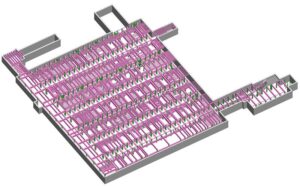The costs of building wooden houses tend to be lower compared to those of brick, concrete, and steel houses. They are cheaper to build because timber is widely available, they can be erected in shorter periods, and cost less in terms of labor. This makes wood a desirable option for price-conscious residents and developers. However, the total cost-effectiveness of a wooden house depends not only on the initial cost.
The long-term durability, maintenance, insulation requirements, and pest control, as well as the susceptibility to fire or moisture, may influence the overall ownership costs. Although wooden houses are a cheaper initial investment, proper planning of the constant maintenance required and fluctuations in climate within the area are essential when determining whether they are the most cost-effective solution in the long term.
1. Initial Construction Costs: Wood vs. Other Materials
Wood is usually a cheaper substitute when compared to materials such as concrete or steel because several factors are involved:
- Material Cost: Wood is easily accessible and is usually cheaper per square foot as compared to concrete or steel.
- Labor Cost: It is easier to build a wooden home, and in most cases, takes a shorter time to complete, hence saving on the labor costs.
- Foundation: Wooden houses are additionally lightweight and might not need as costly a foundation as brick or concrete houses.
- Tools and Machinery: It may be easier to buy less specialized equipment, which can also lower costs when building with wood.
A wooden house could be 10–30% cheaper to construct than a similar-sized house made of masonry materials (brick or concrete), depending on the location and design decisions. To get an accurate cost comparison early on, many builders use on time estimating services to predict and control costs from the planning phase.
2. Construction Time: Faster Equals Cheaper
Time is money in building. It is possible to construct a wooden home much quicker than any masonry or steel structure. Construction of prefabricated wooden frames, or modular houses, can be executed within weeks instead of months.
Rapid construction diminishes:
- Labor hours
- Rental prices of the sites
- Utility installation and office expenses
- Intra-housing or storage expenses
Faster construction schedules may spell huge savings in general.
3. Flexibility and Design Efficiency
Wood is a very flexible and modifiable material. This means:
- The custom designs are easier to apply
- Renovations or extensions are less expensive
- Modifications, as they are constructed, can occur with minimal hitches
This versatility prevents expensive waiting and re-engineering, which makes wood an appealing building material to the cost-conscious homeowner and builder.
4. Long-Term Costs and Maintenance
Although the purchasing costs of wooden houses are lower, they might be associated with a greater expenditure over the years in maintenance services:
Termite Damage: Wooden structures may be attacked by termites or other pests unless they are well-treated.
Moisture Problems: Wood may become decayed or distorted when not properly sealed and ventilated.
Fire Risk: Wood is more prone to fires compared to brick or concrete unless it incorporates fire-resistant products.
Painting and Sealing: Wood is often required to get periodic painting, sealing, or staining to maintain a good condition.
Conversely, the brick and concrete materials are usually less maintenance in the long term and may have a longer life in particular climates.
5. Climate and Environmental Factors
The cost of the wooden house might be a bad investment based on your area:
Dry Climates: Wood can be installed in dry climates where there is less moisture and less mold.
Humid Climates: High humidity results in the problem of warping, rot, and pests, and increases the cost of maintenance.
Earthquake-Prone Areas: Wood buildings are more flexible when it comes to earthquakes because they are lightweight.
Fire-prone Areas: Wooden-built houses are more dangerous in areas where there are wildfires unless they make special use of treated materials.
Therefore, wood can be cheaper at the very beginning, yet its cost-effectiveness can barely rely on local circumstances in the long run.
6. Energy Efficiency & Insulation
Wood is a natural insulator, that is:
- Improved climatic control within the house
- Reduced energy heating and cooling expenses
- Less insulation is required than in the case of steel or concrete structures
This may result in energy savings over a long time, particularly in areas prone to excessive heat or cold weather.
7. Resale Value and Insurance
Although the resale value is highly variable, wooden houses may at times be appraised at lower values than the concrete, brick, and mortar houses in cities or in locations where the wood construction is not prevalent.
The high costs of insurance can also be on wooden homes, because of the:
- Higher risk of fire
- Pest vulnerability
- Reduced durability under some conditions
When selecting wood, buyers ought to consider possible insurance and resale implications.
8. Environmental Sustainability
Wood is an environmental building material as it is renewable and sustainable, particularly in responsible sources:
- Carbon is stored in wood, and this lowers the carbon footprint of your home.
- It consumes less energy in production as compared to concrete or steel.
- Wood construction waste is biodegradable and can be recycled with fewer problems.
This makes wood an appealing, low-cost option for eco-conscious builders.
9. Modular Homes of Wood and Prefabrication
The prefabricated or modular wooden home is becoming an increasing trend in low-cost housing. These are houses built in factories:
- Manufactured in larger quantities, reducing prices
- Portable and simple to set up
- Offered in numerous designs, in numerous sizes
Wooden prefabricated houses can be constructed at a very low cost compared to regular homes, as prices vary between 50 $ to 150$ per square foot based on the features and location.
10. Summary: Are Wooden Houses Cheaper?
Pros:
- Reduced initial cost of construction
- Quicker construction time
- Convenient design customization
- Natural insulation (energy savings)
- Environmentally sustainable
- Prefabricated/modular housing applications
Cons:
- Increased maintenance in certain weather types
- Greater risk of fires and pests
- Conceivably increased insurance rates
- Flexible resale value
Final Verdict
Wooden houses are generally cheaper to construct initially than their brick counterparts, concrete houses, or steel structures. Wooden houses are an economical and versatile idea, especially for individuals who have low budgets or construct houses in areas where favorable climatic conditions are experienced. Yet other aspects like maintenance, climate suitability, fire resistance, and insurance should be taken into account in the long term.
When you have a planned construction and you are considering wood as a key building material, talk to local contractors, architects, and engineers. They will aid in determining whether a wooden house will be viable depending on your budget, location, and lifestyle demands.
A wooden house can be a long-term investment in the right hands, and making the right plans can make it a smart and cheap investment.
FAQS
What makes wooden houses less expensive to build than concrete or brick homes?
The cost of wooden houses is usually less as timber is cheaper and they are easier to construct as well as less manpower is needed. Precut lumber and reduced structural weights also can contribute to reduced transport and site costs, and wood buildings can be cheaper at the outset.
Are wooden houses more expensive to maintain over time?
They may be, according to climate and quality of construction. Timber houses might need frequent care to guard against wetness, vermin, rot, and fire damage. It requires proper sealing, treatments, and periodic inspection, and this can increase the long-term cost over other, more durable materials such as concrete and brick.






